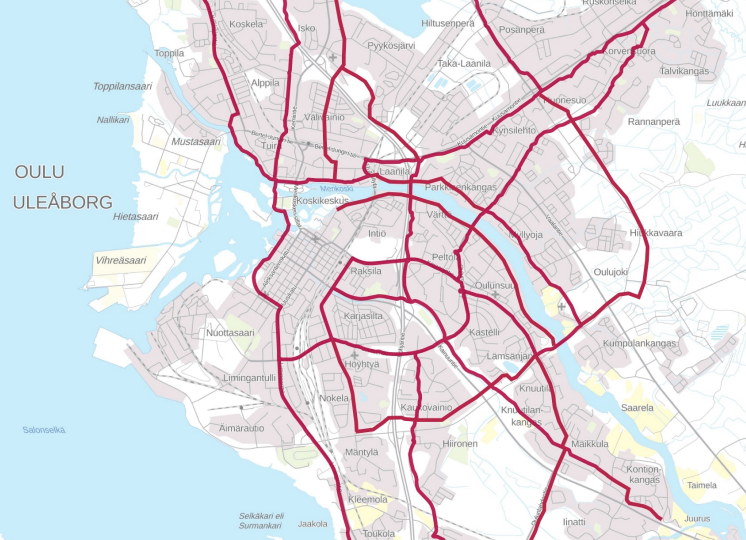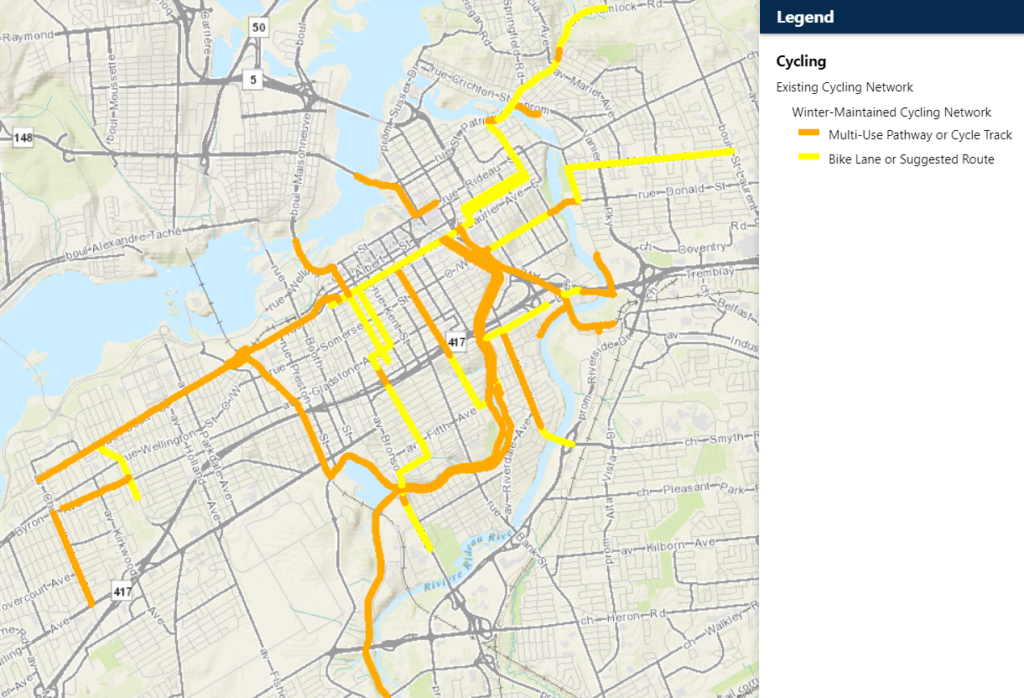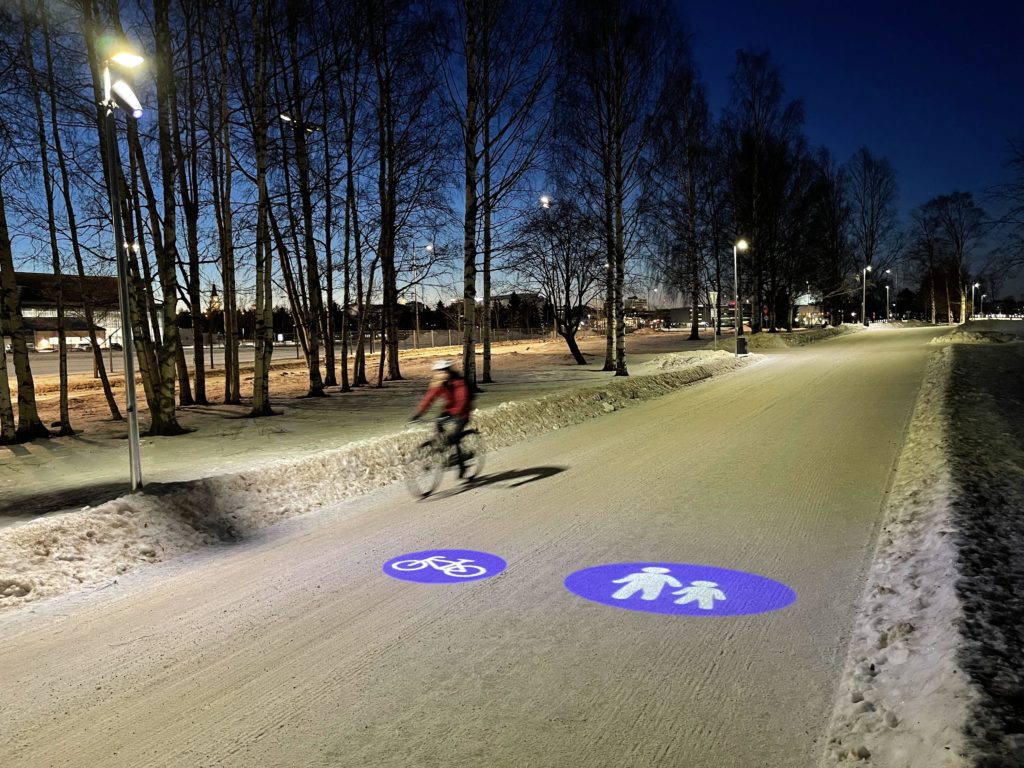When the Snow Flies: A Guide for Winter Cycling Success – Part 2
Now that you know the importance of planning a good cycling network and designing streets with all four seasons in mind (and if you don’t, revisit Part 1 here), let’s dig into the key considerations to make sure your year-round cycling network can actually be used year-round.
Designating the Winter Cycling Network
Ideally, your entire cycling network should be your winter cycling network. As mentioned in Part 1, the most frequented destinations don’t change from season to season, so your cycling network shouldn’t change either. In Montreal, Canada for example, 717 km of the city’s 901 km cycle network (~80 percent) is accessible year-round. However, in the event of a snowfall, not every facility can be cleared immediately. Hence the importance of prioritization.
Maintenance Standards
Every community will have some set of standards when it comes to winter maintenance. These standards typically define at least three levels of maintenance, designating which routes are serviced, the snowfall thresholds at which snow clearing begins, the timeframe within which maintenance should occur, and any other relevant details. It’s here where the municipality can prioritize routes for their winter network, ensuring key connections are accessible after major winter events.
Oulu, Finland – the unofficial winter cycling capital of the world, with a cycling mode share of 12 percent in winter – has three levels of winter maintenance for their 930 km of cycling facilities. Their highest priority routes – deemed Class Super – includes 165 km of facilities in the regions of Oulu and Kempele and serve as key routes connecting surrounding neighbourhoods to the city centre, as well as to each other. These routes are cleared of snow within three hours of 2 cm of accumulation (between 5 am and 11 am) or 4 cm of accumulation (between 11 am and 5 am). Rather than aiming for bare pavement, Oulu leaves a thin layer of packed snow and applies anti-skid treatment through “gritting or graining” the lane’s surface with sand or gravel. This practice avoids the use of environmentally degrading road salt and helps reduce the impacts of freeze-thaw cycles on the pavement.

Figure 1. Class Super winter maintained cycling network in Oulu, Finland. For many communities, this network would represent a good overall winter cycling network. In Oulu, this map only shows the highest priority of maintenance (which extends further out into the surrounding areas). For the full map of Class Super routes click here. For an interactive map with all maintenance classes click here
In Canada, Ottawa is making strides to become one of the top winter cycling cities. The City is nearing completion of a Winter Maintenance Quality Standards review and has begun implementing improved standards that rival those of Oulu. These new standards see the City aiming to clear the winter cycling network within four hours of 2.5 cm of accumulation. However, the winter cycling network only includes about 60 km of routes, which represents less than 20 percent of the more than 350 km of cycling routes maintained by the City. Cycling facilities outside the designated winter cycling network are maintained according to the same standards as the roadways and sidewalks beside which they are located.

Figure 2. Winter cycling network in Ottawa, Canada (source: https://maps.ottawa.ca/geoottawa/).
Table 1. Winter maintenance standards in Oulu, Finland and Ottawa, Canada. Note that the standards listed below for Ottawa are not yet official but are being implemented in practice as the Winter Maintenance Quality Standards review wraps up.
| Oulu, Finland | Ottawa, Canada | |
| Priority 1 | The cycle lane is cleared of snow within three hours from when the amount of snow on the ground is 2 cm (between 5 am and 11 am) or 4 cm (11 am to 5 am). Slush is removed when its amount on the ground is 2 cm (between 5 am and 11 pm) or 3 cm (11 am to 5 am). Anti-skid treatment includes gritting or graining the lane’s surface. When the cycle lane freezes over, anti-skid treatment is carried out within three hours or when the lane is noticeably slippery. | Clearing of Highway 174, the Transitway, major roads and arterials will begin at the start of accumulation and within 4 hours after the last snowflake has fallen. |
| Priority 2 | The pedestrian and cycle paths are ploughed of snow within four hours of when the amount of snow on the path is 3 cm. On weekday mornings, paths are ploughed of nightly snowfall by 7 am and by 4 pm. Slush is removed when its amount on the ground is 2 cm. The path is gritted or salted within three hours of when the path is noticeably slippery. | Sidewalks in the downtown core and the winter cycling network will be cleared within 4 hours of 2.5 cm of accumulation. |
| Priority 3 | The pedestrian and cycle paths are ploughed of snow within six hours of when the amount of snow on the ground is 5 cm and immediately after maintenance class I. Slush is removed when its amount on the ground is 4 cm. The paths are gritted or salted within four hours of when the paths are noticeably slippery. | Secondary roads and minor collectors will be cleared within 6 hours of 5 cm of accumulation. |
| Priority 4 | n/a | Residential sidewalks will be cleared within 16 hours of 5 cm of accumulation. |
| Priority 5 | n/a | Residential roads and lanes will be cleared within 16 hours of 7 cm of accumulation. |
| Source: | https://www.ouka.fi/en/street-maintenance/snow-ploughing-and-anti-skid-treatment?accordion=accordion-24810 | https://ottawa.ca/en/parking-roads-and-travel/roads-sidewalks-and-pathways/snow-plowing-and-clearing#section-34963a8f-9284-4de8-bea1-1004aaae419b |
While Ottawa’s new and improved maintenance practices are some of the best in Canada and should be celebrated, the comparison of winter-maintained networks in Oulu and Ottawa demonstrates how far the City – and the majority of cities in Canada – have to go to become world-class winter cycling cities like Oulu and others in Finland.
Other Considerations
There are many other details to consider to ensure a high-quality cycling network through the winter. Good maintenance extends beyond standards and requires proper equipment and materials. The type and size of brush or blade that is equipped on a plow will vary depending on the width of the facilities and amount of snow to be cleared. Materials that provide grip or melt ice such as sand, gravel, salt, and brine each have their own pros and cons and should be examined before deciding which is most appropriate.
Good lighting is another element that cannot be overlooked. Given that winter sees significantly shorter days, morning and evening commutes as well as evening errands could all be done in the dark. Well-lit cycling routes improve the visibility of the path ahead, improving users’ physical safety in addition to creating a more inviting environment by increasing their sense of personal safety.

Figure 4. A well-lit active transportation facility in Oulu, Finland. Note the symbols indicating to users which facility is for cyclists and which is for pedestrians. These symbols are projected onto the path from a light stand (source: https://oulu.com/en/living/mobility/cycling/).
Finally, budget can be a significant barrier to maintaining a high-quality cycling network year-round. As any winter city can attest to, snow removal is expensive. But it is also a reality of life in northern climates and one that can be (relatively) easily planned for year after year. If we really want to enable and encourage cycling year-round, our municipal budgets need to reflect this.
Humans are creatures of habit. We generally don’t like change and prefer to stick to our routines. By creating a safe and comfortable cycling network that can be used in all four seasons, we create an environment where cycling is not just an activity for the warm days, but a routine mode of transportation all year long.
 ">
">Eric Post
“I believe one of the most effective ways for us to reduce our impact on the environment is to transition to more environmentally sustainable forms of transportation. Building cities where walking and cycling are safe, easy, and enjoyable is a win for all community members and the planet.”

